
Saqqara, also spelled Sakkara or Saccara in English, is an Egyptian village in the markaz (county) of Badrashin in the Giza Governorate, that contains ancient burial grounds of Egyptian royalty, serving as the necropolis for the ancient Egyptian capital, Memphis. Saqqara contains numerous pyramids, including the Pyramid of Djoser, sometimes referred to as the Step Tomb, and a number of mastaba tombs. Located some 30 km (19 mi) south of modern-day Cairo, Saqqara covers an area of around 7 by 1.5 km.

The pyramid of Djoser, sometimes called the Step Pyramid of Djoser, is an archaeological site in the Saqqara necropolis, Egypt, northwest of the ruins of Memphis. It is the first pyramid to be built. The 6-tier, 4-sided structure is the earliest colossal stone building in Egypt. It was built in the 27th century BC during the Third Dynasty for the burial of Pharaoh Djoser. The pyramid is the central feature of a vast mortuary complex in an enormous courtyard surrounded by ceremonial structures and decoration.
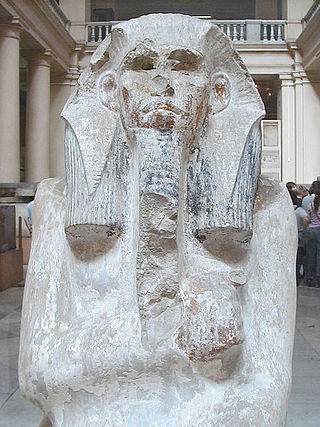
Djoser was an ancient Egyptian pharaoh of the 3rd Dynasty during the Old Kingdom, and was the founder of that epoch. He is also known by his Hellenized names Tosorthros and Sesorthos. He was the son of King Khasekhemwy and Queen Nimaathap, but whether he was also the direct successor to their throne is unclear. Most Ramesside king lists identify a king named Nebka as preceding him, but there are difficulties in connecting that name with contemporary Horus names, so some Egyptologists question the received throne sequence. Djoser is known for his step pyramid, which is the earliest colossal stone building in ancient Egypt.

The Egyptian pyramids are ancient masonry structures located in Egypt. Sources cite at least 118 identified "Egyptian" pyramids. Approximately 80 pyramids were built within the Kingdom of Kush, now located in the modern country of Sudan. Of those located in modern Egypt, most were built as tombs for the country's pharaohs and their consorts during the Old and Middle Kingdom periods.

Hor-Aha is considered the second pharaoh of the First Dynasty of Egypt by some Egyptologists, while others consider him the first one and corresponding to Menes. He lived around the 31st century BC and is thought to have had a long reign.

Nynetjer is the Horus name of the third pharaoh of the Second Dynasty of Egypt during the Early Dynastic Period. Archaeologically, Nynetjer is the best attested king of the entire dynasty. Direct evidence shows that he succeeded Raneb on the throne. What happened after him is much less clear as historical sources and archaeological evidences point to some breakdown or partition of the state.

Huni was an ancient Egyptian king, the last pharaoh of the Third Dynasty of Egypt during the Old Kingdom period. Following the Turin king list, he is commonly credited with a reign of 24 years, ending c. 2613 BC.

Merneith was a consort and a regent of Ancient Egypt during the First Dynasty. She may have been a ruler of Egypt in her own right, based on several official records. If this was the case and the earlier royal wife Neithhotep never ruled as an independent regent, Merneith may have been the first female pharaoh and the earliest queen regnant in recorded history. Her rule occurred around 2950 BC for an undetermined period. Merneith’s name means "Beloved by Neith" and her stele contains symbols of that ancient Egyptian deity. She may have been Djer's daughter and was probably Djet's senior royal wife. The former meant that she would have been the great-granddaughter of unified Egypt's first pharaoh, Narmer. She was also the mother of Den, her successor.
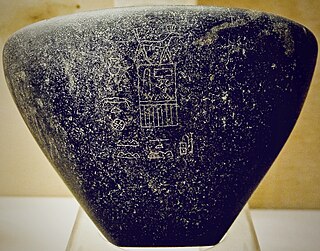
Seth-Peribsen is the serekh name of an early Egyptian monarch (pharaoh), who ruled during the Second Dynasty of Egypt. His chronological position within this dynasty is unknown and it is disputed who ruled both before and after him. The duration of his reign is also unknown.
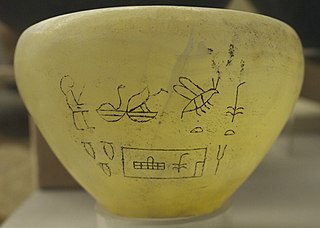
Semerkhet is the Horus name of an early Egyptian king who ruled during the First Dynasty. This ruler became known through a tragic legend handed down by the historian Manetho, who reported that a calamity of some sort occurred during Semerkhet's reign. The archaeological records seem to support the view that Semerkhet had a difficult time as king and some early archaeologists questioned the legitimacy of Semerkhet's succession to the Egyptian throne.
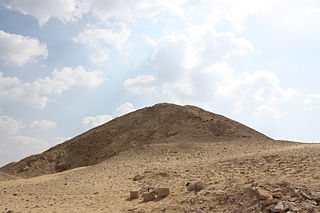
The pyramid of Teti is a smooth-sided pyramid situated in the pyramid field at Saqqara in Egypt. It is the second known pyramid containing pyramid texts. Excavations have revealed a satellite pyramid, two pyramids of queens accompanied by cult structures, and a funerary temple. The pyramid was opened by Gaston Maspero in 1882 and the complex explored during several campaigns ranging from 1907 to 1965. It was originally called Teti's Places Are Enduring. The preservation above ground is very poor, and it now resembles a small hill. Below ground the chambers and corridors are very well preserved.

The Mastabat al-Fir'aun is the grave monument of the ancient Egyptian king Shepseskaf, the last king of the Fourth Dynasty documented to date. It is located in South Saqqara halfway between the Pyramid of Djoser at Saqqara and the pyramids of Sneferu, the founder of the Fourth Dynasty, at Dahshur. The structure is located close to the pyramid of Pepi II, a ruler of the Sixth Dynasty. The stone quarry for the structure is located west of the Red Pyramid of Sneferu.

Tarkhan is an ancient Egyptian necropolis, located around 50 km south of Cairo on the west bank of the Nile. The cemetery was excavated in two seasons by Flinders Petrie. Tombs of almost all periods were found, but most importantly many belonging to the time of Egyptian state formation, the Early Dynastic period around 3100 BC. Petrie found more than 2,000 tombs, most of them simple holes in the ground belonging to common people. However, there were also several mastabas of the First Dynasty, decorated with a palace facade.
Herneith was a Queen consort of ancient Egypt. She lived during the 1st Dynasty. The name herneith means "The face of Neith".

Kagemni was a vizier from the early part of the reign of King Teti of the Sixth Dynasty of Egypt. Kagemni's wife Nebtynubkhet Sesheshet was a King's Daughter and likely the daughter of Teti.
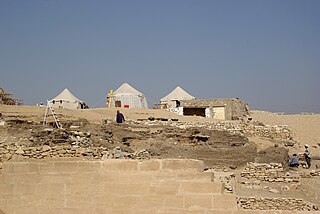
The Mastaba of Hesy-re is an ancient Egyptian tomb complex in the great necropolis of Saqqara in Egypt. It is the final resting place of the high official Hesy-re, who served in office during the Third Dynasty under King Djoser (Netjerikhet). His large mastaba is renowned for its well-preserved wall paintings and relief panels made from imported Lebanese cedar, which are today considered masterpieces of Old Kingdom wood carving. The mastaba itself is the earliest example of a painted tomb from the Old Kingdom and the only known example from the Third Dynasty. The tomb was excavated by the Egyptologists Auguste Mariette and James Edward Quibell.
Shepset-ipet was an ancient Egyptian princess living during the late 2nd Dynasty. She may have been the daughter of king (pharaoh) Peribsen or Khasekhemwy. She is known by her decorated slab stela.

Mastaba S3503 is a large mastaba tomb at the Saqqara necropolis in Lower Egypt. The burial was constructed around 3000 BC during the 1st Dynasty of Ancient Egypt.
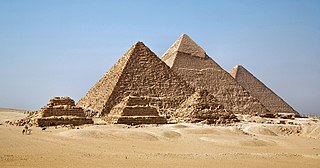
In ancient Egypt, the term house of eternity refers to a tomb that consists of a pit, a tomb shaft, or from mudbricks, which were later carved into rocks; or built on open land. Burial sites made of stone were a "sign of immortality", due to the long durability of stone. This was an ideal construction method that could be afforded by only a very few ancient Egyptians, due to its high cost. In ancient Egyptian mythology, the construction of a monument during one's own lifetime represented the most intensive representation with the connection of life; and the concept of living in the afterlife.
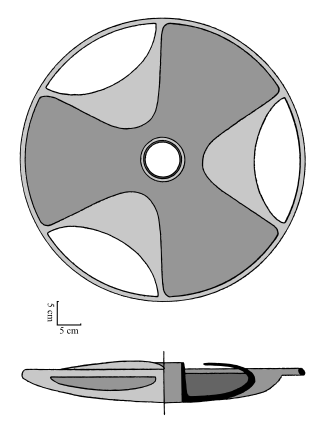
The Sabu disk is an ancient Egyptian artifact from the First Dynasty, c. 3000 to 2800 BC. It was found in 1936 in the north of the Saqqara necropolis in mastaba S3111, the grave of the ancient Egyptian official Sabu after whom it is named. The function and meaning of the carefully crafted natural stone vessel are unclear.


















